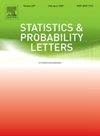绝对原始矩的高斯乘积不等式
IF 0.7
4区 数学
Q3 STATISTICS & PROBABILITY
引用次数: 0
摘要
给出了实值阶绝对原始矩的高斯乘积不等式(gpi),其中阶包括负号和混合号(正负)。gpi用于具有单一参数的结构相关矩阵,在每个模型中显示具有非零共同平均值的复合对称和自回归模式。在二元情况下,对于绝对原始矩,我们有一个扩展的所谓的反向GPI。GPIs由已知的高斯积绝对原始矩级数公式得到。本文章由计算机程序翻译,如有差异,请以英文原文为准。
Gaussian product inequalities for absolute raw moments
Gaussian product inequalities (GPIs) for absolute raw moments of real-valued orders are shown, where the orders include negative signs and mixed ones (positive and negative). The GPIs are for structural correlation matrices with a single parameter showing compound symmetric and autoregressive patterns with a non-zero common mean in each model. In the bivariate case, we have an extended so-called opposite GPI for the absolute raw moments. The GPIs are obtained by a known series formula of the Gaussian product absolute raw moments.
求助全文
通过发布文献求助,成功后即可免费获取论文全文。
去求助
来源期刊

Statistics & Probability Letters
数学-统计学与概率论
CiteScore
1.60
自引率
0.00%
发文量
173
审稿时长
6 months
期刊介绍:
Statistics & Probability Letters adopts a novel and highly innovative approach to the publication of research findings in statistics and probability. It features concise articles, rapid publication and broad coverage of the statistics and probability literature.
Statistics & Probability Letters is a refereed journal. Articles will be limited to six journal pages (13 double-space typed pages) including references and figures. Apart from the six-page limitation, originality, quality and clarity will be the criteria for choosing the material to be published in Statistics & Probability Letters. Every attempt will be made to provide the first review of a submitted manuscript within three months of submission.
The proliferation of literature and long publication delays have made it difficult for researchers and practitioners to keep up with new developments outside of, or even within, their specialization. The aim of Statistics & Probability Letters is to help to alleviate this problem. Concise communications (letters) allow readers to quickly and easily digest large amounts of material and to stay up-to-date with developments in all areas of statistics and probability.
The mainstream of Letters will focus on new statistical methods, theoretical results, and innovative applications of statistics and probability to other scientific disciplines. Key results and central ideas must be presented in a clear and concise manner. These results may be part of a larger study that the author will submit at a later time as a full length paper to SPL or to another journal. Theory and methodology may be published with proofs omitted, or only sketched, but only if sufficient support material is provided so that the findings can be verified. Empirical and computational results that are of significant value will be published.
 求助内容:
求助内容: 应助结果提醒方式:
应助结果提醒方式:


